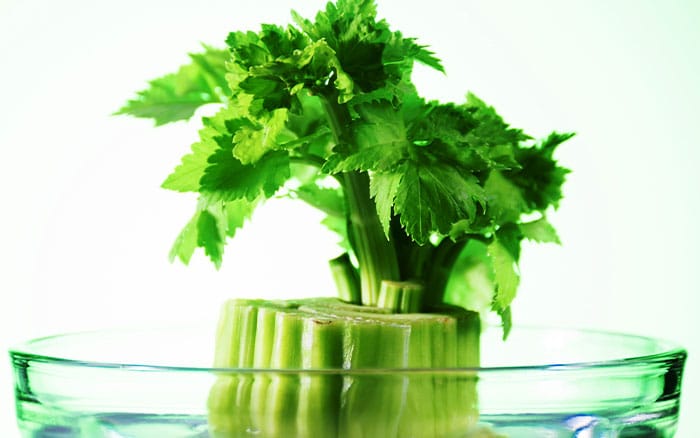Vegetables bring so much to the table. They are versatile, tasty, nutritious, and add plenty of colour to our dishes. But when you’ve finished cooking with them and there are leftover scraps, you may be surprised to know that you can re-grow more veg from these pieces.
Not only will this save you money but it’s fascinating to watch the process of regeneration and regrowth. Here is a selection of some common vegetables that can be regrown from scraps and leftovers.
Celery
First is an easy and popular one to regrow. All that’s needed is to cut the bottom of the celery off and place it in a shallow container with some lukewarm water in the bottom the base is in the water.
Place the container in a sunny, warm spot and the celery will happily re-grow. In about a week, leaves will be growing, and these can be cut off as needed. Alternatively, the celery can be replanted in the garden so it grows into a larger plant once again.

Spring onions & leeks
Other easy vegetables to re grow are these, which grow quickly too. When you’re done with the veg, simply place the root (1-2 inches) into a jar of water, so the top of the onion is above the water surface. Ideally, choose the onions that have more roots that are chunkier, this will mean it will grow easier and faster.
Then place in a bright spot, and within a few days it will grow. Replace the water with clean water every so often to keep it fresh.

You can also grow them in a small container of soil rather than water, using the same method, but planting them up with a good peat-free compost and placing in full sun and regularly watered.
By doing this you can have an endless supply of spring onions from your scraps.
Onions
Although there are many vegetables that can be re-grown in water, onions tend to do better when regrown in soil. To start, cut the onion bottoms at the root end so it’s about 1 inch thick.
Then, the onions can be placed with the roots facing downwards into a container filled with moist peat-free compost. Add a small layer of soil on top and keep the compost moist but not wet. Within a few weeks roots will have grown and there will be green shoots growing.

The green shoots can be cut and used in dishes like spring onions. However, if you are looking to grow larger onions, keep the greens in place so they can give the bulb plenty of nutrition to grow. The onions will need to be transplanted into larger pots or into the ground so they can continue to grow their best.
Garlic
Garlic is a staple ingredient in many dishes, and you can have a continuous supply by regrowing them from scraps.
It really is as easy as separating the cloves and planting them into soil or a container. Then the cloves grow to form a full bulb, with their own cloves that can be used, divided, and planted again.

If planting in the garden, choose a spot with well-drained soil whether that is in the ground, a raised bed, or container. When planting, dig in some organic matter to supply a boost of the necessary nutrients.
Choose a garlic bulb that is large and cut the bulb into cloves like you would when cooking with a clean, sterilised knife. Then, wash each one. Plant each clove 15cm apart, with the flat end facing downwards and the pointed end facing up. Push the cloves about 5cm deep into the soil and cover over with soil.
Keep on top of care by watering to keep the soil moist and feeding with a balanced fertiliser.
Lettuce
Regrowing lettuce is another easy win. Romaine lettuce is a great one to try, but any type of lettuce will work as long as there’s still a stem intact.
To get started, ensure there is about 2 inches of the base for the best growth and remove any leaves from it, so it is just the stem left. Then, place the stem into a bowl or class, with the cut side facing upwards in a layer of water.

You want the stem to sit in the water rather than being fully submerged. If the container is wide or the stem is unsteady, stick a couple of toothpicks into the lower side of the leftover to keep it balanced.
When it’s in place, put the container on a windowsill with plenty of sun, and with a good few hours of light a day, you will see growth. Refresh the water in the container every other day. Within 7 days you should see growth sprouting and within 12 days there should be little lettuce leaves ready for you to harvest for your salads and sandwiches.
This way, you won’t grow a full lettuce, but you’ll make the most of your leftovers with little effort for a few more leaves for your dishes.
Re grow vegetables from seeds
Saving seeds is always a good idea. Whether you are saving them to be planted or to be eaten. For example, save pumpkin seeds to roast and keep as a tasty crunchy snack.
Alternatively, if they’re not edible, store them safely in a dry spot until it’s time to replant them.


Great news re the regrowing of some veg. I know you can do this with pineapples, but never tried it with veg. Will now though..